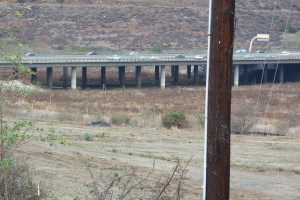- View of Lake Hodges. Photo by Sarah Hughes
By Elizabeth Cruz
Governor Jerry Brown has declared a state of emergency and urges Californians to conserve as much water as possible.
Much of California is experiencing extreme and exceptional drought conditions for the third consecutive year, making it the driest 30 months in over 100 years according to climate.gov. Currently, California is suffering from depleted amounts of available water, as well as below average rainfall that is causing crops to fail. Such a threat affects all Californians, as food and water may be at risk. Even around campus, there are changes one can make to conserve water.
Drought is defined by Webster’s Dictionary as a period of dryness, especially when prolonged. Droughts are more dangerous than dry spells in that they last longer and can sometimes take decades to fully develop. They are in the top three threats to world population, according to weather.about.com.
In Southern California, imported water is relied on heavily. Only 20 percent of the water consumed is local according to sdcoastkeeper.org. The rest is imported from the Colorado River and Sacramento/San Joaquin River Delta. With those areas also affected by drought conditions, Southern Californians have to recognize the value of conservation, considering most of the reservoirs in California are only at 50 percent capacity today.
USA Today reports that earlier this year, President Obama authorized $100 million in drought aid to farmers in order to cover the loss of livestock. He ordered the Agriculture Department to expedite applications so farmers can receive aid in a timely manner. Obama has also advised federal facilities to limit water consumption.
Governor Brown signed a $687.4 million dollar package on March 1 to aid California during the water crisis, calling it the worst in modern history for the state. The bulk of the funding will go to local governments for water conservation projects. The rest will be given to Californians who need general food assistance and house related assistance as a result of the drought, as well as the Emergency Water Fund.
The storm that hit at the beginning of March helped reduce the risk of wildfires, but did not bring enough precipitation to bring the drought even close to an end. Unfortunately, most of the snow caused from the storm will flow into the ocean instead of into our reservoirs, according to the Union Tribune, and it looks like this was the last big storm of the winter season.
Adam Allgood of the National Oceanic and Atmospheric Administration’s Climate Prediction Center anticipates drought conditions will persist or worsen in many of the already affected areas.
More efficient equipment can conserve water and regulatory practices can monitor human behavior. Water reuse for landscaping can help to save drinkable water for more vital purposes. CSUSM has many drought-tolerant plants that may help reduce water used in landscaping.
Students and staff can conserve water at home by simply waiting to run a dishwasher until it is full. This can save 10 to 20 gallons of water a day, according to the United States Environmental Protection Agency. For those without dishwashers, washing dishes by hand in a stopped sink or container, is an excellent alternative to letting the sink run while doing the chore.
Also, turning off the faucet while brushing one’s teeth or shaving and taking shorter showers lasting one to five minutes can have impacts on the water supply.


